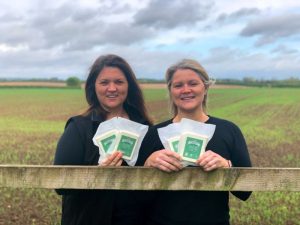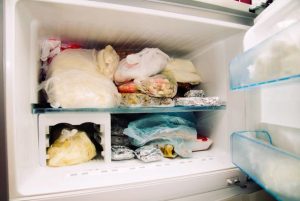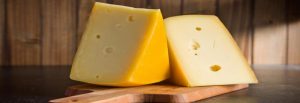
- The earliest reports of cheese made and sold here date to the 17th century. In 1724, English writer Daniel Defoe referred to the town being “famous for cheese,” calling the product the “English Parmesan.”
- Today, Stilton can only be made in six dairies, which are spread across three counties in England: Nottinghamshire, Leicestershire, and Derbyshire.
- We visited Colston Bassett Dairy in Nottinghamshire to learn more about the cheese is made.
Following is a transcript of the video.
Claudia Romeo: Today we’re in the village of Colston Bassett in Nottinghamshire, England, to learn more about how blue Stilton cheese is made. Today we’re going to learn about its history and origin, and I will also be getting my hands dirty in the process. And then, of course, we’re going to taste it.
This cheese can only be made in six dairies, which are spread across three counties here in England, which are Nottinghamshire, Leicestershire, and Derbyshire. And today we’re going to visit Colston Bassett Dairy, which is one of the six dairies making Stilton cheese. Stilton cheese takes its name from the village of Stilton, in the east of England. The earliest reports of cheese made and sold here date to the 17th century. In 1724, English writer Daniel Defoe referred to the town being “famous for cheese,” calling the product the “English Parmesan.”
What contributed to its popularity was that Stilton was relatively close to London, only 70 miles away. The town was on the Great North Road. Built by the Romans, this road was the only link between London and Edinburgh before modern motorways took over. The road passed through villages and market towns filled with coaching inns. One of these was The Bell Inn, where a lady named Frances Pawlett sold her cheese to travelers, and the word of her Stilton cheese quickly started to travel with them. And though she probably did not invent the cheese herself, she is responsible for expanding its popularity beyond the village.
Billy Kevan: That was her route to market. It was basically a wayfares for the carriages, so people would stop overnight, and a lot of the cheese was sold there and taken down to London by travelers.
Claudia: As its popularity grew, Stilton cheese started to be made in the surrounding areas. Today, Stilton production has strict geographical borders and is confined to three counties in England. Ironically, as the village of Stilton falls outside of the county’s borders, there can’t be any cheese made in Stilton called Stilton.
Colston Bassett Dairy was founded in 1913 as a cooperative to save excess milk from farms in the village from going to waste. Today, the dairy works with four farms that supply 4 million liters of milk a year.
Billy: Over, you know, the last 100-and-something years, we’ve gone from making three months a year, probably making 50, 60 cheese a day, to making seven days a week, and we are doing, in peak, about 180 cheese a day.
Claudia: The farms send the milk to the dairy, where it is pasteurized.
Billy: What we do is we take the milk, we add a blue mold culture, starter culture to produce acidity, and then we add rennet, which will help us clot the milk and turn it into curd. Once we’ve set it and it looks like a giant jelly, a giant white jelly, we’ll cut the curd, release the moisture, and we’ll drain that moisture off. Quite specific to us, all of our cheese will be hand-ladled from vat to trolley. And that’s just the transfer of curd from one large vessel to another. That will give us moisture release without losing too many fatty proteins to whey. Mechanized processes, large-scale business, people who are transferring large volumes, can and do lose fatty proteins to whey. We do, but just less, because we’re doing it by hand.
Claudia: If you think that ladling is just about transferring the curds from one vat to another, think again. Billy showed me how to do it, and I had a go myself.
Billy: So, the thing to remember is not to dig. Keep it quite flat and just push it through.
Claudia: And that’s it?
Billy: Very good. OK, so you also need to…. It needs to all come down to the same depth. So you can’t have some deep, some not. So it needs to be exactly the same, all the way down. Same here.
Claudia: So, I’m just gonna try one more for the road.
Billy: And that bit of cheese is now dead. And you can let Craig have it, and we’ll get on with it.
Claudia: [laughs] Thank you. So, you know when you say, “One day I’m gonna quit everything and become a cheesemaker”? [laughs] Not an easy task. You have to think it through.
Billy: So, once we’ve ladled, we will then allow it to settle, and again, more whey will come out. And then you will drain that whey. And once you start draining the whey, the bacteria that’s in the curd will start to multiply and produce quite a high level of lactic acid overnight. And then the next morning, we’ll come in, and at a specific lactic acid point, we will break the curds by milling, so it’s a uniform size, we’ll hand-salt the curds, hand-mix the curds, and form it up into a cheese hoop, as you see behind me.
Claudia: The cheese is placed in a warm room to allow some of the moisture to evaporate. The cheese is turned every day, and when it’s dry enough and can stand on its own, the mold is taken off.
Billy: We need to stop the aerobic mold growing at that stage, because if you make it grow too quickly with Stilton, it won’t taste right, because you’re changing the pH too quickly. So we will take a knife, and we will actually rub the outside of the cheese. And by rubbing the outside of the cheese, we create a barrier, so no oxygen can get inside. And we stop the mold growth, or the blue mold growth, at that particular stage of production.
Claudia: Then the wheels are turned every day. When they’re five or six weeks old, they are pierced to allow oxygen in, which will activate the blue mold and produce the Stilton’s characteristic blue veins. Then the cheese matures for another five weeks.
Billy: Put it on straight and then turn it. All the way around. Right, now gently bring it out.
Claudia: So this one is almost ready, yeah?
Billy: Almost. Not quite. I mean, the other end might not be quite so firm, because they don’t mature in uniform. So, what we should see, it’ll start the blueing process from the center and work out, so we can tell, looking at that, it’s not ready yet because it’s not fully blue. Mind your finger when you’re bringing it back out. So, push into the center, stop, finger on. Now use your other hand.
Claudia: Like that?
Billy: Finger on, use your thumb, and have it up in the gap, and then pull it out gently. And then just clean it so that that’s covering the hole.
Claudia: We’ve got a slice of freshly cut Stilton, so, I’m so excited to give this a try. First thing that I want to point out about this is that it’s not that smelly. You know how blue cheeses have this reputation for being so smelly. It’s actually all right. Oh, it’s so good. It just disappeared. It just melted, like that. The texture is nice and crumbly. Even if this is some sort of hard cheese, so it’s not that creamy, it actually is on your palate. It has some, like, sweet hints at the beginning, when you first taste it. And then you’re left with a bit of salty aftertaste, which is incredible. I mean, you know, you get two different flavors in one bite. It’s so good. I’m gonna have another one. The sweetness of the blue veins, so good, and also if you get a mini piece without the blue, that in itself, it’s marvelous. And, again, the texture is incredible. So crumbly, and it’s something that I haven’t had with other blue cheeses that are kind of gummy. This one is so nice, melts in your mouth, incredible.
Stilton is a registered trademark by the Stilton Cheesemakers’ Association, which was founded in 1936. The trademark protects the cheese in countries including the US, Canada, and Japan. Within the EU, the cheese was also granted the Protected Designation of Origin, in 1996.

























